Build-A-Rig Round 2, SilverStone vs. Crucial: The $800 PC Showdown
by Daniel Williams on November 12, 2015 8:00 AM EST- Posted in
- Build-A-Rig
- Systems
- Crucial
- SilverStone
Gaming Performance
No back-to-school experience would be complete without some (ed: a lot) of gaming, so let’s take a look at the gaming performance of our two systems. One of the interesting aspects about games is that their CPU demands are fairly static – they scale with framerate, but not much else. So even though the performance gap between CPUs and GPUs is much greater at the high-end, with these $800 systems there’s a greater question of whether we’re going to be CPU-limited to begin with since we’re using dual-core CPUs.
We’ll start off our look at gaming performance then with our synthetic 3DMark gaming benchmarks. When working across vendors these benchmarks can be a little more problematic, but since both systems are using GeForce GTX 900 series cards, we should get some reliable results for how the gaming performance of the two systems differs.
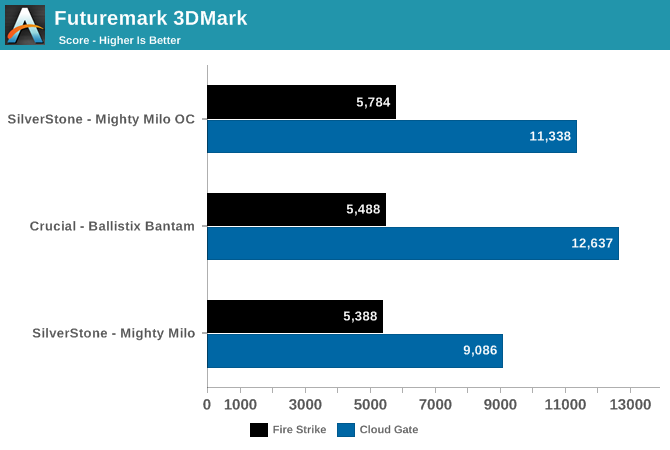
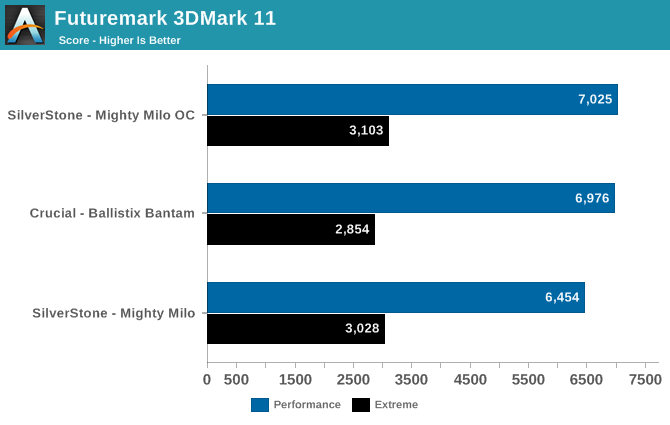
In both 3DMark tests that were ran we actually see our earlier system performance trend continue for a little bit longer. Corsair’s Ballistix Bantam, despite packing a slower GeForce GTX 950 video card, actually edges out the SilverStone build thanks to the performance impact of the CPUs. However once overlcocked, the Mighty Milo can take the lead thanks to a combination of a higher clockspeed and its more powerful video card. Though even then the Corsair build still rules at 3DMark Cloud Gate.
Moving on to our real world gaming benchmarks, we’ll start with The Talos Principle. Croteam’s first person puzzle and exploration game The Talos Principle may not involve much action, but the game’s lush environments still put even fast video cards to good use. Coupled with the use of 4x MSAA at Ultra quality, and even a tranquil puzzle game like Talos can make a good case for more powerful video cards.
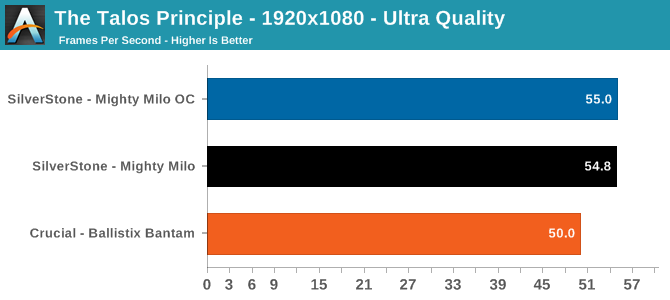
Right off the bat the Mighty Milo takes an easy 10% lead in performance, though it’s good to see that both systems aren’t having any problem staying at a nice and smooth 50+ frames per second. It’s a bit surprising that the difference between the two systems isn’t greater given the video cards, but then again it’s easy to forget that GTX 950 can hold up to GTX 960 rather well at times.
For the racing game in our benchmark suite we have Codemasters’ GRID Autosport. Codemasters continues to set the bar for graphical fidelity in racing games, delivering realistic looking environments layerd with additional graphical effects. Based on their in-house EGO engine, GRID Autosport includes a DirectCompute based advanced lighting system in its highest quality settings, which incurs a significant performance penalty on lower-end cards but does a good job of emulating more realistic lighting within the game world.

Here we actually see very minimal difference between the two machines. Watching CPU usage history while the benchmark was looping I saw CPU utilization lingering up in the 90% and up region, indicating that GRID is solidly CPU-limited in these conditions. This consequently is also why overclocking the Mighty Milo had such an impact, since it directly deals with the immediate bottleneck.
Up next we have Crysis 3. With Crysis 3, Crytek has gone back to trying to kill computers and still holds the “most punishing shooter” title in our benchmark suite.
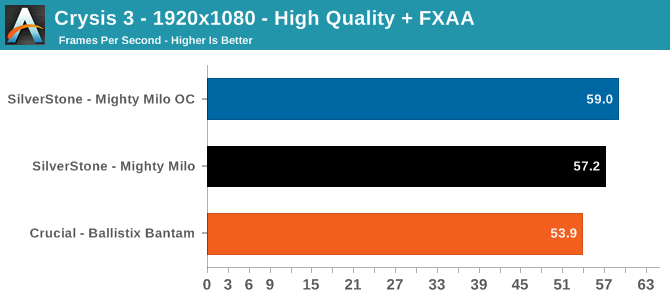
With Crysis 3 the stock SilverStone builds pulls comfortably ahead with a lead of 7%, thanks to its more powerful video card. Overclocking the Pentium G3258 has a minor impact here, netting us a couple more frames per second and almost squeaking out a 60fps average. What's worth bringing up from my notes though is there was pretty much no difference in minimum fps on the Mighty Milo. So while scores are higher here it may not feel that different when performance is really needed.
The open world action game in our benchmark suite is Grand Theft Auto V. The latest edition of Rockstar’s venerable series of open world games, Grand Theft Auto V was originally released to the last-gen consoles back in 2013. However thanks to a rather significant facelift for the current-gen consoles and PCs, along with the ability to greatly turn up rendering distances and add other features like MSAA and more realistic shadows, the end result is a game that is still among the most stressful of our benchmarks when all of its features are turned up.
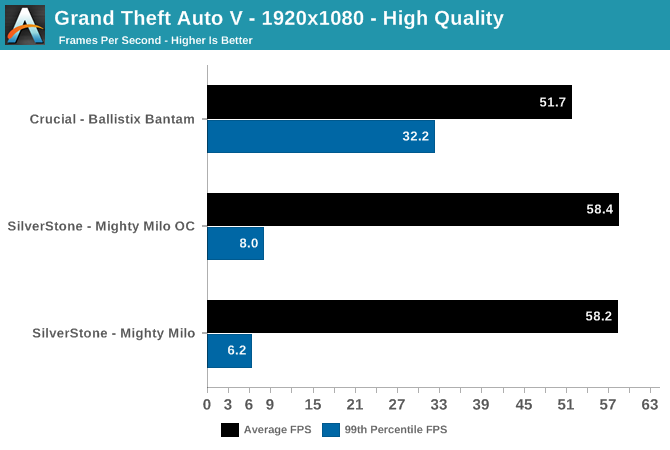
Both of our builds here today put out admirable averages under GTAV, each averaging over 50fps. However the 99th percentile frame times tell us a different story. Here the Mighty Milo struggles worse than usual here and stalls every couple of seconds. With the minimum CPU requirement for this game being a quad-core processor and seeing the GPU load running very erratically it would appear that even with an overclock the Pentium G3258 struggles to provide a consistent experience. Despite its lower average framerate the Ballistix Bantam does a much more admirable job of maintaining a smooth playing experience.
Our final gaming benchmark is the latest iteration of Valve’s massively popular MOBA, Dota 2 Reborn. The Reborn edition marks the move to the Source 2 engine, and has significantly altered the playing field as far as performance goes, with Valve stating that the new engine is even more scalable to low-end hardware than the already low-end friendly Source 1 version of Dota 2.
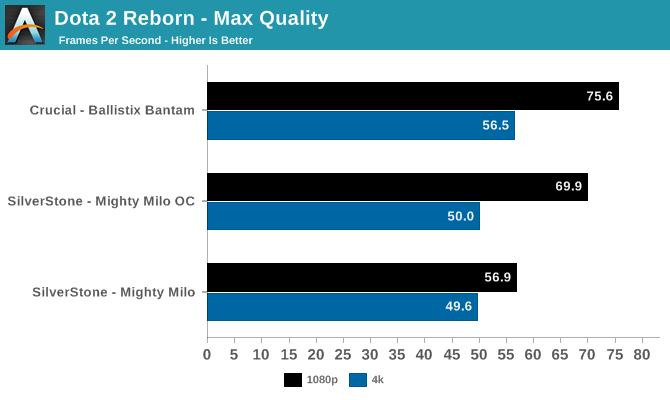
Here I encountered a few surprises with our new Dota 2 benchmark. When I first started testing I used 1080p at maximum quality, and then followed-up with 4K at the same quality settings to see how performance scaled with resolution. To my surprise, both of these systems, especially at 1080p, are CPU limited. So much so in fact that we see much smaller framerate drops than we are used to when kicking the game into 4K. In fact this game appears to be so CPU limited that the Pentium running in the Mighty Milo drags the NVIDIA GTX 960 to below what the Core i3-4170 can do with the NVIDIA GTX 950. This is a great example of how even games aren't exclusively a GPU benchmark.
Finally, while looking at gaming performance we’re also taking a look at GPU compute performance via CompuBench 1.5. Backed by OpenCL, we’ve picked out three of the benchmark’s suites best sub-tests, highlighting different use cases for GPU compute in modern systems.
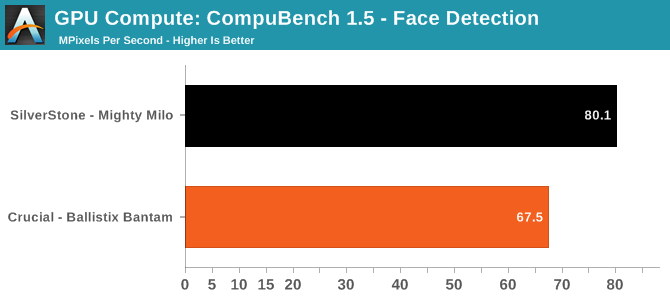
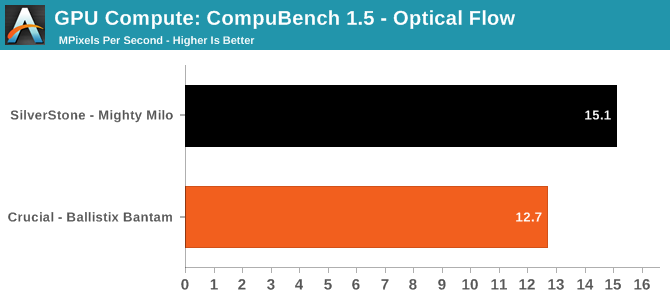

In compute we see that the GTX 960 found inside SilverStone’s Mighty Milo practically trounces the GTX 950 we see in Crucial's Ballistix Bantam. For any workloads that can lean on GPU compute such as video editing, scientific computing, or anything that touches 3D modeling, the GTX 960 will help make for a more effective machine. Assuming of course that some complementary CPU grunt isn't entirely necessary.










43 Comments
View All Comments
nathanddrews - Thursday, November 12, 2015 - link
But... but...https://youtu.be/9gSQg1i_q2g
shmuck - Thursday, November 12, 2015 - link
Damn straight! Somebody's got to do the complaining around here. Harumph.https://www.youtube.com/watch?feature=player_detai...
The privacy information which was missing from the link:
https://www.surveygizmo.com/privacy/
This is a lot more encouraging.
eanazag - Tuesday, November 17, 2015 - link
My only gripe about the contest is it is closed too fast. It seems like you have less than 24 hours to enter it. The first one was confusing because Anandtech used to just place a post on the article and you were "entered". I think I have it figured out now. We just need a few more of these for me to enter.I understand the marketing hope on having it end so quickly. I typically read all the headlines when they're released and then read the articles later.
BrokenCrayons - Thursday, November 12, 2015 - link
Even after benchmarking, I still find it very difficult to favor one system over the other. They're both very solid builds without any show stopping flaws. Either system would serve a college student well in a variety of computing tasks. As usual, I love reading these build-a-rig articles.Samus - Thursday, November 12, 2015 - link
Damn that Silverstone is a sexy beast. Throw in i5-4690k in there and damn...racerx_is_alive - Thursday, November 12, 2015 - link
The only problem with spreading these articles out they way they are is that I'm only 75% sure I signed up for the sweepstakes with the first article, but don't want to do it again and get my entry tossed. But otherwise, I really like the way this series is organized, and the computers they've built.smorebuds - Thursday, November 12, 2015 - link
"IF YOU ENTER MORE THAN ONCE, ALL BUT ONE ENTRY WILL BE DELETED."Sounds like you'll still have an entry in there.
Ryan Smith - Thursday, November 12, 2015 - link
Humm, interesting. I hadn't considered that angle before. Thanks for the feedback.ShieTar - Thursday, November 12, 2015 - link
Nice, but am I the only one that feels that more fun should be poked at the 600W-PSU in the 200W-PC?Just shows that even when somebody knows what they are doing in general, they will always remain capable of messing up on some important detail.
BrokenCrayons - Thursday, November 12, 2015 - link
The 600 watt PSU is excessive for the computer's current hardware, but it might be worth considering the extra wattage as headroom to grow into a more powerful CPU and/or graphics card later without being concerned about wattage. The Core i3-4170 is a 54 watt TDP processor and the GTX 950 is a 90 watt card. Moving up to a GTX 980 would add 75 watts more demand (165 watts total power according to NV's site) and an i7-4770 would need another 30 watts (84 watt TDP). That'd quickly turn the 200+ watt PC into a 300+ watt one which puts the PSU at 50% load which is well into the more efficient areas of its power delivery curve.